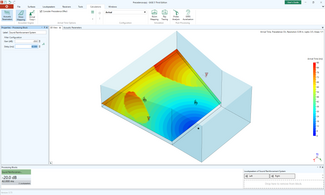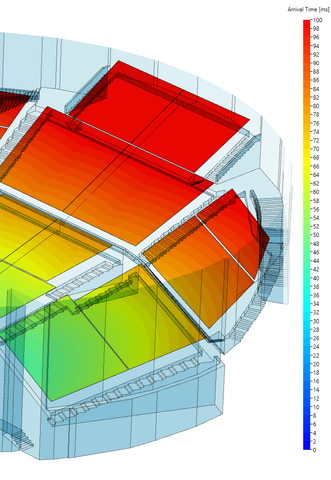Interactive sound reinforcement systems with arrival-time mapping in Acousteer

We are announcing a significant enhancement for sound system design with the release of Version 73 of EASE 5. This version introduces Real-Time Mapping of Arrival Time and Localization integrated into the Acousteer simulation engine. This development offers a more dynamic and precise method for the design, analysis, and optimization of sound reinforcement systems and delay loudspeakers, directly addressing the complexities of achieving accurate sound localization and system coherence.
Live analysis of propagation delay
The arrival time mapping in Acousteer provides a sophisticated visual representation of the total propagation delay. This is not limited to simple time-of-flight calculations from source to listener but critically encompasses the cumulative effect of all signal processing delays. These include delays introduced by individual loudspeakers, filter settings, as well as those from overarching processing blocks, thereby accounting for every stage of the DSP chain. This comprehensive calculation, updated in real time as system parameters change, offers an accurate depiction of when acoustic energy, as shaped by the entire system, actually arrives at any given point within the defined audience areas of a venue.
Streamlining the optimization of delay loudspeakers

The real-time nature of this feature offers a distinct advantage in the process of assessing, setting up and tuning sound reinforcement loudspeakers. The primary design goal in such systems is to ensure that the audience perceives sound as originating from the primary source (e.g., the stage), with delay loudspeakers seamlessly reinforcing the sound without drawing attention to themselves.
Immediate feedback on adjustments: Modifications to loudspeaker placement, orientation, gain, or delay settings trigger an instantaneous update of the arrival time map. This allows users to observe the direct consequences of their settings across the entire listening area without the delay of traditional iterative calculation processes.
Precise localization verification: The option to consider the precedence effect (Haas effect) allows users to toggle a psychoacoustic model that helps determine if a delayed loudspeaker's signal will be perceived as a distinct, localizable source or, as an integrated part of the main system's sound. This is crucial for verifying that the intended localization on the primary source is maintained.
Efficient iteration and fine-tuning with stored configurations: Users can store and toggle through different delay settings and sound system configurations to achieve coherent arrival times and optimal localization by comparing different solutions instantly. This contrasts sharply with conventional methods that involve time-consuming sequences of measurement and adjustment.
The Acousteer engine, at the heart of EASE 5's real-time capabilities, redefines the acoustician's workflow far beyond just arrival times. It also provides immediate visual feedback for direct SPL coverage across the full audio bandwidth (20 Hz to 20 kHz). This means users can instantaneously see the impact of adjustments to loudspeaker positioning, aiming, gain and filtering, on both coverage levels and temporal characteristics. This opens up new avenues for fine-tuning that were previously impractical or overly time-consuming with iterative, non-real-time methods.
The ability to explore subtle adjustments and their complex interactions in a live scenario leads to novel calculation settings that are precisely tailored to the particulars of each project. Being able to save and recall complete simulation configurations, including all parameters for SPL and arrival time, further enhances this agile workflow, allowing for rapid A/B comparisons and efficient documentation of the design evolution.
The introduction of real-time arrival time mapping in EASE 5 Third Edition, powered by the Acousteer engine represents one more step in EASE’s journey towards a fully interactive solution for acoustic simulation. The new feature will be showcased for the first time at InfoComm 25, Orlando, Florida.

Evaluate this feature with our free EASE 5 Trial.